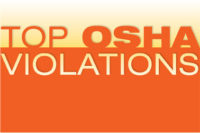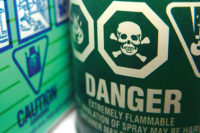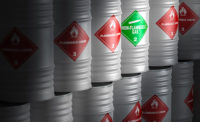2020 Top Standards: OSHA most frequently violated standards
Hazard Communication (1910.1200)

OSHA’s hazard communication standard was the second most-frequently cited agency standard in FY 2019.
Enforcement citations FY 2019: 3,624
Number of inspections: 2,024
Proposed penalties: $4,682,380
Most frequently cited industries:
- Manufacturing
- Construction
- Other Services (except Public Administration)
- Wholesale Trade
Background
The Hazard Communication Standard (HCS) is now aligned with the Globally Harmonized System of Classification and Labeling of Chemicals (GHS). This update to the Hazard Communication Standard (HCS) will provide a common and coherent approach to classifying chemicals and communicating hazard information on labels and safety data sheets. This update will also help reduce trade barriers and result in productivity improvements for American businesses that regularly handle, store, and use hazardous chemicals while providing cost savings for American businesses that periodically update safety data sheets and labels for chemicals covered under the hazard communication standard.
In order to ensure chemical safety in the workplace, information about the identities and hazards of the chemicals must be available and understandable to workers. OSHA's Hazard Communication Standard (HCS) requires the development and dissemination of such information:
- Chemical manufacturers and importers are required to evaluate the hazards of the chemicals they produce or import, and prepare labels and safety data sheets to convey the hazard information to their downstream customers;
- All employers with hazardous chemicals in their workplaces must have labels and safety data sheets for their exposed workers, and train them to handle the chemicals appropriately.
Major changes to the Hazard Communication Standard
- Hazard classification: Provides specific criteria for classification of health and physical hazards, as well as classification of mixtures.
- Labels: Chemical manufacturers and importers will be required to provide a label that includes a harmonized signal word, pictogram, and hazard statement for each hazard class and category. Precautionary statements must also be provided.
- Safety Data Sheets: Will now have a specified 16-section format.
- Information and training: Employers are required to train workers by December 1, 2013 on the new labels elements and safety data sheets format to facilitate recognition and understanding.
Requirements
As of June 1, 2015, the HCS requires new Safety Data Sheets to be in a uniform format, and include the section numbers, the headings, and associated information under the headings below:
- Section 1, Identification includes product identifier; manufacturer or distributor name, address, phone number; emergency phone number; recommended use; restrictions on use.
- Section 2, Hazard(s) identification includes all hazards regarding the chemical; required label elements.
- Section 3, Composition/information on ingredients includes information on chemical ingredients; trade secret claims.
- Section 4, First-aid measures includes important symptoms/effects, acute, delayed; required treatment.
- Section 5, Fire-fighting measures lists suitable extinguishing techniques, equipment; chemical hazards from fire.
- Section 6, Accidental release measures lists emergency procedures; protective equipment; proper methods of containment and cleanup.
- Section 7, Handling and storage lists precautions for safe handling and storage, including incompatibilities.
- Section 8, Exposure controls/personal protection lists OSHA’s Permissible Exposure Limits (PELs); ACGIH Threshold Limit Values (TLVs); and any other exposure limit used or recommended by the chemical manufacturer, importer, or employer preparing the SDS where available as well as appropriate engineering controls; personal protective equipment (PPE).
- Section 9, Physical and chemical properties lists the chemical's characteristics.
- Section 10, Stability and reactivity lists chemical stability and possibility of hazardous reactions.
- Section 11, Toxicological information includes routes of exposure; related symptoms, acute and chronic effects; numerical measures of toxicity.
Steps to an effective hazard communication program
Employers that have hazardous chemicals in their workplaces are required by OSHA’s Hazard Communication Standard (HCS), 29 CFR 1910.1200, to implement a hazard communication program. The program must include labels on containers of hazardous chemicals, safety data sheets (SDSs) for hazardous chemicals, and training for workers. Each employer must also describe in a written program how it will meet the requirements of the HCS in each of these areas. Employers can implement an effective hazard communication program by following these six steps:
Step 1. Learn the standard/identify responsible staff
- Obtain a copy of OSHA’s Hazard Communication Standard.
- Become familiar with its provisions.
- Make sure that someone has primary responsibility for coordinating implementation.
- Identify staff for particular activities (e.g., training).
Step 2. Prepare and implement a written hazard communication program
- Prepare a written plan to indicate how hazard communication will be addressed in your facility.
- Prepare a list or inventory of all hazardous chemicals in the workplace.
Paragraph (e) of the standard requires employers to prepare and implement a written hazard communication program. This requirement is to help ensure that compliance with the standard is
done in a systematic way, and that all elements are coordinated.
Step 3. Ensure containers are labeled
- Keep labels on shipped containers.
- Label workplace containers where required.
Chemical manufacturers and importers are required to provide labels on shipped containers with the following information: product identifier, signal word, pictograms, hazard statements, precautionary statements, and the name, address and phone number of the responsible party.
Step 4. Maintain Safety Data Sheets (SDSs)
- Maintain safety data sheets for each hazardous chemical in the workplace.
- Ensure that safety data sheets are readily accessible to employees.
Safety data sheets are the source of detailed information on a particular hazardous chemical. Employers must maintain copies of SDSs for all hazardous chemicals present in their workplaces. If you do not receive an SDS from your supplier automatically, you must request one. You also must ensure that SDSs are readily accessible to workers when they are in their work areas during their work shifts.
Step 5. Inform and train employees
- Train employees on the hazardous chemicals in their work area before initial assignment, and when new hazards are introduced.
- Include the requirements of the standard, hazards of chemicals, appropriate protective measures, and where and how to obtain additional information.
Step 6. Evaluate and reassess your program
- Review your hazard communication program periodically to make sure that it is still working and meeting its objectives.
- Revise your program as appropriate to address changed conditions in the workplace (e.g., new chemicals, new hazards, etc.).
|
2020 Top Standards Article Index ANSI/ISEA 121- Dropped object prevention solutions NFPA 652 standard on fundamentals of combustible dust OSHA most frequently violated standardsFall protection- General Requirements (1926.501) Hazard Communication (1910.1200) The Control of Hazardous Energy (Lockout/Tagout) 1910.147 Respiratory Protection (1910.134) Powered Industrial Trucks (1910.178) |
Looking for a reprint of this article?
From high-res PDFs to custom plaques, order your copy today!





